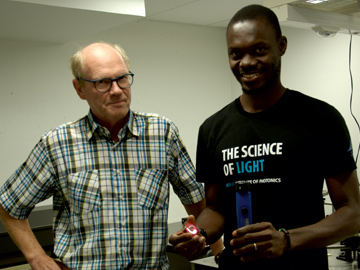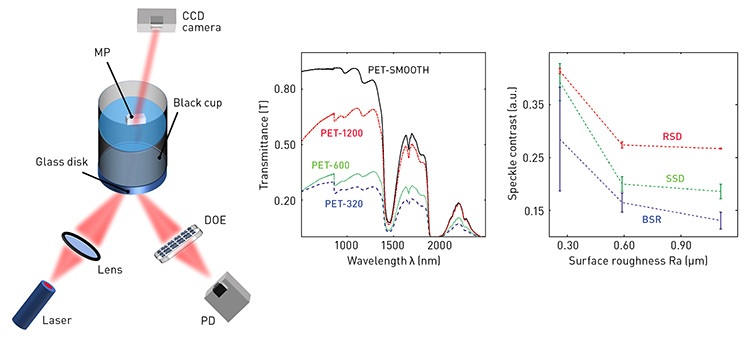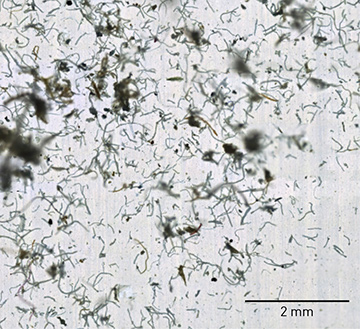 [Getty Images]
[Getty Images]
On a sunny July day, a kid plays with a plastic bottle on the shore. Later, the polyethylene terephthalate (PET) bottle is swept away by a wave and ever further seaward by ocean currents. Thus begins a long degradation process: What began as a simple bottle of mineral water is carried by waves, ground by sand, attacked by salt and weakened by sunlight. The plastic changes slowly in composition, its originally smooth surface becomes rough, and the bottle is fragmented into countless smaller pieces.
The extensive use of plastic bottles and other plastic products started in the 1970s, only some 50 years ago. But already, waste plastics, mainly concentrated at major ocean gyres (large systems of rotating ocean currents), have emerged as a serious environmental problem. It will take between a hundred and a thousand years for the forgotten plastic bottle to degrade into macro- (> 5 mm in size), micro- (≤ 5 mm, MP), sub-micro- (100 nm to 1 µm) and nano-plastics (< 100 nm, NP).
The plastic bottle that found its way by accident into the ocean is no longer innocent, and humans can no longer avoid the problems it raises. However, limiting the consequences begins by finding ways to detect harmful particles. In this feature, we look at some optical approaches to microplastics detection.
 Microplastic (MP) samples collected in a 2018 study from the coastal beach soils in Shandong province include (a) mixed microplastics, (b) pellets, (c) foams, (d) fragments, (e) flakes, (f) films, (g) fibers (fishing lines), and (h) sponges. [Reprinted from Geoderma, 322, Q. Zhou et al. (2018), with permission from Elsevier.]
Microplastic (MP) samples collected in a 2018 study from the coastal beach soils in Shandong province include (a) mixed microplastics, (b) pellets, (c) foams, (d) fragments, (e) flakes, (f) films, (g) fibers (fishing lines), and (h) sponges. [Reprinted from Geoderma, 322, Q. Zhou et al. (2018), with permission from Elsevier.]
Pervasive problem
Production of conventional plastics begins with crude oil as the raw material. That means that synthetic plastics contain hydrocarbons with spectral fingerprints in the near-infrared (NIR) and visible (VIS) range, which allows spectroscopic tracking of the material. Each plastic has a different spectral fingerprint that can be used to identify it, even in harsh environmental conditions. Spectroscopic methods are applied, for instance, in plastic waste circulation plants, allowing the identification of the plastics supposed to have been collected for recycling.
Unfortunately, because of human activities, not all waste plastics are recycled or burned for energy production; some appear as litter in the environment. With a biodegradation rate lower than 12% and degradation time of a hundred years, some of the most common plastics—for example, PET, polylactic acid (PLA) and polyvinyl alcohol (PVA)—persist in the environment. Ultraviolet (UV) light leading to photobleaching, and mechanical erosion by waves, winds and interaction with sand in seas, causes bulk plastics to degrade into microplastics.
Environmental pollution and health issues due to microplastics and nanoplastics have emerged as an important interdisciplinary research topic.
Recent studies suggest that even in open water, such particles take a very long time to degrade into pieces smaller than 1 mm. MPs can have different sizes and structures—such as, fiber, film, sponge or pellet—depending on the plastic’s type and the surrounding environmental conditions. MPs resulting from the decomposition of macro-plastics are called secondary MPs; MPs that come from products like toothpastes or scrub creams, in which microbeads are used in production, are called primary MPs.
Environmental pollution and health issues due to MPs and NPs have emerged as an important interdisciplinary research topic, spurring numerous studies on the consequences, detection and the collection of the particles. MPs can be found everywhere on the planet. From production lines to waste disposal sites, plastics are dispersed, mainly by humans, into the natural world and find their way to open water, such as lakes, rivers and seas, where they will contaminate small organisms, such as algae and plankton, that are in turn consumed by larger animals. MPs also occur in the atmosphere and on land, where, slowly buried in the ground, they will pollute the soil and end up in plant roots.
MPs are nearly unavoidable. Drinking water, groundwater, atmosphere, the Arctic, soil, and commercial salt are all examples of direct or indirect sources of MPs that affect humans. The problem affects the entire food chain, posing a severe food safety challenge. In some environments, MPs degrade even more, becoming rough and porous and acting as hosts for various bacteria, viruses, toxic metals and other pollutants. Indeed, attention has been drawn to MP-contaminated environments as possible breeding grounds for antibiotic-resistant human pathogens.
 MPs are everywhere in the environment, and circulate through many organisms, collecting pollutants, heavy metals, bacteria and disease until they are trapped in algae and plankton, feeding fish, birds and humans. [Illustration by Phil Saunders]
MPs are everywhere in the environment, and circulate through many organisms, collecting pollutants, heavy metals, bacteria and disease until they are trapped in algae and plankton, feeding fish, birds and humans. [Illustration by Phil Saunders]
Optical detection of microplastics
MP research is still in its infancy, and analysis has commonly involved, for example, harvesting MPs from aquatic environments, preparing dry samples and arranging plastic types for identification and chemical study, to explore the basic properties of MPs. However, it is challenging to identify plastic particles and determine their size and concentration outside of a chemistry lab, in the natural environment. In natural water bodies, for instance, organic small particles are also present, and the changing thermodynamic properties of water and air can likewise disturb the measurements. Even amid these complications, optical measurement techniques offer great potential for efficient sensing of MPs via in situ automated detection systems.
Well-established optical measurement techniques already form the basis of popular methods for identifying MPs in laboratory settings. Among them, Fourier-transform infrared (FTIR) spectroscopy and Raman spectroscopy have shown very promising results. These techniques can provide the characteristic spectral signature of the polymers constituting the plastics, which allows for screening of the MPs. However, samples require heavy preprocessing in the lab to avoid spectral artifacts generated by organic or inorganic particles other than MPs.
FTIR and Raman spectroscopy, coupled with microscopy, yield both image information on MP size and spectral data for MP identification. Raman microspectroscopy can even detect MPs smaller than 20 micrometers. Nevertheless, these methods are commonly used to study harvested microplastics for onshore or laboratory measurements. Fluorescence is another important method. Tagging plastics using dyes (for example, Nile red) has been applied for imaging MPs with blue light, and nonlinear optical methods based on stimulated Raman scattering offer still another suggested approach.
 Kai-Erik Peiponen (left) and Benjamin O. Asamoah (right) with a portable glossmeter. [Courtesy of Matthieu Roussey]
Kai-Erik Peiponen (left) and Benjamin O. Asamoah (right) with a portable glossmeter. [Courtesy of Matthieu Roussey]
Real-world challenges
Recently, Lulu Lv and colleagues reported a big step toward practical sensors for in situ detection of MPs in aquatic environments with the aid of surface-enhanced Raman spectroscopy (SERS). Jan Ornik and colleagues, meanwhile, have demonstrated the first laser-based photoluminescence screening of MPs, which can discriminate between MPs and organic particles such as algae that are typically present in fresh waters. Clear, transparent aquatic environments, although complex, provide easier conditions for detecting MPs than turbid, muddy or polluted waters. Digital holography (DH), which allows both the size and type of MPs to be accessed through their optical properties (for example, absorption and refractive index), has been suggested for MP imaging and identification in marine environments in the presence of organic particles. But chasing MPs in a matrix of highly turbid water remains a challenging task.
MP detection typically requires combining many advanced technologies. Shungudzemwoyo Garabaa and Heidi Dierssen have recently suggested the potential for airborne hyperspectral imaging using short-wavelength NIR radiation. In this work, they mounted hyperspectral cameras on unmanned aviation vehicles (UAVs) to screen locally floating MPs. By concentrating on spectral features around λ = 1200 nm, the team avoided the strong absorption bands of water while partly or fully covering the spectral features of the MPs.
Floating colored MPs are usually easier to detect—for example, via hyperspectral imaging in the visible band—than transparent or translucent MPs. The low refractive-index difference between plastics and water makes them nearly invisible, especially in case of MPs that have been subjected to a long period of erosion in the water. Mechanical erosion, for example, causes surface roughening, which turns a plastic that is translucent in air into one that is nearly transparent and invisible in water. Surface roughening is a sign of the residence time of MPs in aquatic environment.
In the past year, our research group has explored the effects of MP surface roughness on the transmission spectrum—and has prototyped a handheld device that could be used to efficiently detect the presence of MPs in water and to observe the effects of surface roughness. Such a system can provide additional information by combining the results of the speckle contrast and the transmission from a MP-containing water sample. For instance, the surface micro-roughness on one side or both sides of the MP can be revealed by comparing the speckle contrasts calculated from the measured speckle patterns. The handheld device is also useful for studying MP sedimentation from wastewater sludge—potentially addressing a difficult issue in detecting MPs that are in sediment or in the water column experiencing sedimentation.
 Left: Schematic of a handheld device, reported in 2020, for sensing MPs. CCD, charge-coupled device (without objective lens; DOE, diffractive-optical element; PD, photodiode. Right: Such a device can evaluate surface roughness, a key indicator of residence time, through an analysis of transmission spectra (center) and speckle contrast (right). SSD, smooth side down; RSD, rough side down; BSR, both sides roughened. [Reprinted with permission from Elsevier: B.O. Asamoah et al., Chemosphere 254, 126789 (2020); B. Kanyathare et al., Chemosphere 248, 126071 (2020)] [Enlarge graphic]
Left: Schematic of a handheld device, reported in 2020, for sensing MPs. CCD, charge-coupled device (without objective lens; DOE, diffractive-optical element; PD, photodiode. Right: Such a device can evaluate surface roughness, a key indicator of residence time, through an analysis of transmission spectra (center) and speckle contrast (right). SSD, smooth side down; RSD, rough side down; BSR, both sides roughened. [Reprinted with permission from Elsevier: B.O. Asamoah et al., Chemosphere 254, 126789 (2020); B. Kanyathare et al., Chemosphere 248, 126071 (2020)] [Enlarge graphic]
Putting optical MP sensors to work
The results briefly surveyed above highlight the promise of optical methods for in situ detection of MPs in aquatic environment. Optics is fast, is non-invasive for the samples and the environment, and offers many properties from which to extract data. Where is the field headed now?
 Recorded micrograph of MPs from filtrated wastewater sludge includes about 50% identified as PET particles and fibers. [Emilia Uurasjärvi and Kalle Ryymin]
Recorded micrograph of MPs from filtrated wastewater sludge includes about 50% identified as PET particles and fibers. [Emilia Uurasjärvi and Kalle Ryymin]
A realistic picture about the abundance and dispersion of MPs in aquatic environments requires not just laboratory measurements, but also in situ probing and monitoring. Although most of the individual technologies are ready, some additional work will be required to combine them for the development of both practical optical sensors and the data analysis techniques to support them.
Power supply, data transfer and sample access are the key challenges to tackle in a remotely controlled sensing scheme. For studying natural water bodies, a feasible protocol would be to integrate solar- or wind-powered stand-alone sensors. In one option, data collected by drones—as is already done in forestry and environmental control—and positioned using GPS technology could be transmitted in real time for analysis elsewhere. Access to samples is straightforward in the case of river environments, where water samples flow naturally through a fixed measurement system. In lakes and seas, the sensors can be installed on ferries, cargo ships and in submarines. Sensors could involve different optical units to detect spectra by scanning wavelength within the UV/VIS/NIR range, and could also use lasers, photodiodes and cameras for imaging and for detecting MP light scattering.
 [Illustration by Phil Saunders] [Enlarge graphic]
[Illustration by Phil Saunders] [Enlarge graphic]
Large plastic waste decomposes over time into MPs and also into NPs, which are even more difficult to detect. NP detection by laser light interaction is a more plausible solution than conventional optical spectroscopies. In the laboratory, NP trapping in a tightly focused semiconductor laser beam could allow detection via third-order nonlinear optical processes, such as two-photon absorption. This, however, requires sophisticated technology that is unlikely to be integrated in in situ measurement systems in the near future.
A strong, broad and multidisciplinary effort to address the microplastics challenge will be required to allow our children to continue to play safely in a clean environment.
A key challenge is the extremely low concentration of MPs and NPs in natural water bodies—the “needle-in-a-haystack” problem. Sea currents and gyres, however, may locally concentrate MPs and NPs, aiding their detection with optical sensors. In case of municipal wastewaters, the concentration of unwanted plastic particles is higher, but the measurement environment is harsh compared, for example, with sea water. Collection of MPs and NPs in the atmosphere is also possible, but concentrations there are even lower than in water, making acquisition times very long. Nevertheless, optical methods to detect aerosols in air—for example, light scattering, via devices such as phase Doppler anemometers (LDPAs)—can be exploited. In the identification of airborne MPs, wavelength-dependent absorption and dispersion of the MP are both valuable properties.
MP and NP detection is an emerging research field, pushing science to find solutions to address a looming environmental threat. Photonics is a clean, noninvasive probing tool; it’s reliable, allowing access to most material properties; it’s fast, providing immediate results; and it’s portable, using solutions that have already been developed. Despite the huge advances in optical detection of MPs in the past few years, however, much work remains for developing more efficient in situ detectors using technology that is environmentally friendly and makes wise use of limited Earth resources. A strong, broad and multidisciplinary effort to address the microplastics challenge will be required to allow our children to continue to play safely in a clean environment.
This work is part of the Academy of Finland Flagship Programme, Photonics Research and Innovation (PREIN), decision 321066.
Kai-Erik Peiponen, Benjamin O. Asamoah and Matthieu Roussey are with the University of Eastern Finland, Joensuu, Finland. Boniphace Kanyathare is with the University of Eastern Finland and the Dar Es Salaam Institute of Technology, Dar Es Salaam, Tanzania. Jukka Räty is with the University of Oulu, Kajaani, Finland.
References and Resources
-
G. Vázquez-Guardado et al. “Multi-spectral infrared spectroscopy for robust plastic identification,” Appl Opt. 54, 7396 (2015).
-
S.M. Mintenig et al. “Identification of microplastic in effluents of waste water treatment plants using focal plane array-based micro-Fourier-transform infrared imaging,” Water Res. 108, 365 (2017).
-
C.F. Araujo et al. “Identification of microplastics using Raman spectroscopy: Latest developments and future prospects,” Water Res. 142, 426 (2018).
-
S.P. Garaba and H.M. Dierssen. “An airborne remote sensing case study of synthetic hydrocarbon detection using shortwave infrared absorption features identified from marine-harvested macro- and microplastics,” Remote Sens. Environ. 205, 224 (2018).
-
B.O. Asamoah et al. “A prototype of a portable optical sensor for the detection of transparent and translucent microplastics in freshwater,” Chemosphere 231, 161 (2019).
-
F. Julienne et al. “From macroplastics to microplastics: Role of water in the fragmentation of polyethylene,” Chemosphere 236, 124409 (2019).
-
P. Alexy et al. “Managing the analytical challenges related to micro- and nanoplastics in the environment and food: Filling the knowledge gaps,” Food Addit. Contam. A 37, 1 (2020).
-
B.O. Asamoah et al. “On optical sensing of surface roughness of flat and curved microplastics in water,” Chemosphere 254, 126789 (2020).
-
B. Kanyathare et al. “Optical transmission spectra study in visible and near-infrared spectral range for identification of rough transparent plastics in aquatic environments,” Chemosphere 248, 126071 (2020).
-
L. Lv et al. “In situ surface-enhanced Raman spectroscopy for detecting microplastics and nanoplastics in aquatic environments,” Sci. Total Environ. 728, 138449 (2020).
-
J. Ornik et al. “Could photoluminescence spectroscopy be an alternative technique for the detection of microplastics? First experiments using a 405 nm laser for excitation,” Appl. Phys. B 126, 1 (2020).
-
Q. Yu et al. “Distribution, abundance and risks of microplastics in the environment,” Chemosphere 249, 126059 (2020).

